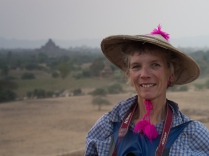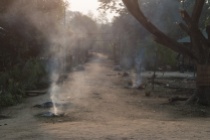Our public transport northwards in Myanmar ended in the town of Tsipaw (Hsipaw), Shan State. It’s a pleasant place, but the attraction there is as a base for hiking into the hills.
Myanmar isn’t exactly a unitary state. It used to be called Burma, reflecting the dominance of the Bamar people. Indeed, they were expanding quite an empire westwards in the early 1800s, until they met the East India Company expanding the other way, attacked, and came off worst. One reason the country’s name changed in 1989, was to be more inclusive of the other people’s the Bamar had (partially) subdued: the Shan, the Palaung, the Mon, and many others. So, hiking in this part of Shan State, we’d meet Shan people, and also Palaung people. Our guide, Aikethein, is a Palaung.
We’d been told our route would be across the fields in the morning heading up into the hills during the afternoon. No such luck. Barely across one field we started on our incline. The broad track occasionally opening out into panoramic views, eventually shrank into a ‘sheep’ trail across the steep edged hills winding it’s way up and down. We didn’t see any sheep, just a few motorbikes.

OLYMPUS DIGITAL CAMERA

OLYMPUS DIGITAL CAMERA

OLYMPUS DIGITAL CAMERA

OLYMPUS DIGITAL CAMERA

OLYMPUS DIGITAL CAMERA

OLYMPUS DIGITAL CAMERA

OLYMPUS DIGITAL CAMERA

OLYMPUS DIGITAL CAMERA

OLYMPUS DIGITAL CAMERA
Forest paths wound over tree roots and rocks as we crunched through the leaf fall, passing cleared areas used for crops, often, at this time of year, burnt to clear them for the next growing season. Towards the end of the day, small plantations of tea bushes ranged up steeper slopes.
A small boy dancing from rock to rock across the burbling brook, swiftly crouching to take aim, catapult in hand. The bird flew off as junior sprang into action again, for another shot. Aikethein fumbled in his bag seizing his catapult for a more experienced attempt. Peeyaang .. another shot flew out but still the bird fluttered away. We now know why we hear, but don’t see, birds in the forest.
We stopped in a Shan village for lunch, although at the house of a Palaung family. Shan and Palaung have their own languages, and the Palaung generally live higher up in the hills, where they grow tea. I nabbed the only chair, a small plastic garden chair the same as a few others on the veranda that stood next to the bamboo ‘deck chair’, the fomer probably for tourists when they arrived. Our food was on a circular low table in a large sparsely furnished room. Our hostess bustled away at a bit of sweeping keeping the room spotlessly clean once we had eaten. The small pile she had swept with her traditional handmade broom quickly disappeared down a lifted floor board to the ground 8 feet below – how neat was that!
The roomy houses are lovely. There’s stuff lying around showing just how much can be made out of bamboo and twine: hats, walls, plumbing, fences, gates, chairs, bridges, it’s endless. There are now some concrete houses, but most are a traditional chunky wood frame with bamboo mat walls. Sometime in the last 100 years, corrugated iron roofs replaced thatch in most cases. The light woven walls keep out the sun but provide ventilation.
The cuisine is one of the many things that defines each culture. We were first introduced to fermented tea leaf salad on the Myanmar International Airways plane where Gid tried it but declined a second helping. Here in the village, having done a days hike and with no other option, we both tucked in.
Aikethein was telling us that whilst the main ingredients may stay the same across regions of Myanmar the method of cooking them has slight changes from village to village. He pointed out that the food we were eating was less greasy than in Hsipaw which we agreed with. Sourbanyan tree leaves, cabbage soup, a solid wad of steamed rice were three of the things on our supper table.
Manns Tan, a Palaung village, perched on the edge of the hillside, is a cluster of 15 houses. There are numerous children all keen to smack your hand in a high 5 greeting calling bye- bye, hello, tata. Relatively recently, the trails to it have been dug out to be passable by motorbike as well as horse. A motorbike can carry two 50Kg bags of rice, plus a bit else.

OLYMPUS DIGITAL CAMERA

OLYMPUS DIGITAL CAMERA

OLYMPUS DIGITAL CAMERA

OLYMPUS DIGITAL CAMERA
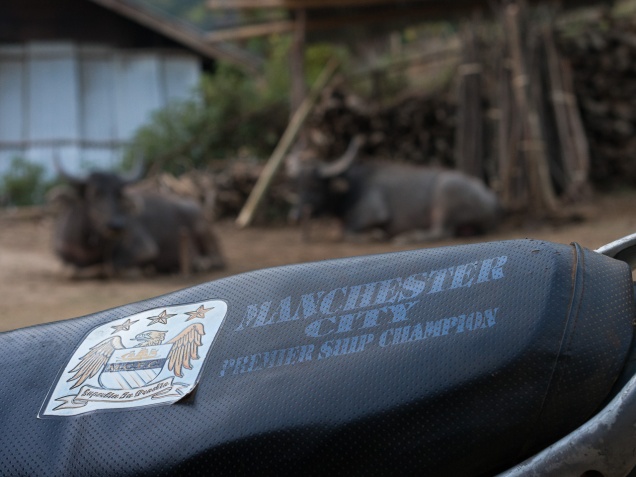
OLYMPUS DIGITAL CAMERA
18km (11miles) walked. Mostly up, as we climbed to around 1000m, amongst small tea plantations and wandering water buffalo whose bells clonked musically as they browsed. Fortuitously, the buffalo don’t eat tea bushes. We noticed the Myanmar (SE Asian) water buffalo are indeed different from Indian.
Aikethein Taw was our guide. His village is 50 km away but is not accessible to foreigners because, like many places in Myanmar, there are civil, and not so civil, disputes between tribes fighting over the natural resources in the land. He left his village to move to the ‘city’ as he didn’t want to be a farmer, and has been guiding now for quite a few years. He has big ideas for more work in the growing tourist trade.
Aikethein is one of twelve siblings. Two of his brothers died from cocaine addiction, one from measles which in the last ten years is now immunized against. In families where there are three male children one has to join the “army” (that is, the tribal militia, not the national army, whom they may fight). In villages where there are less than thirty children there is no formal education but children will often be sent to a nunnery or monastery at the age of six or seven and are free to leave when they like.
















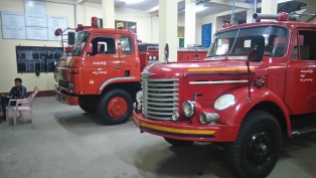






















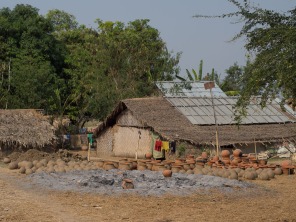







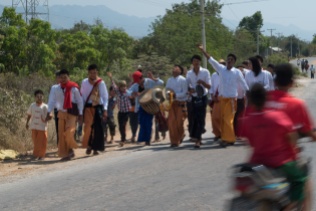


























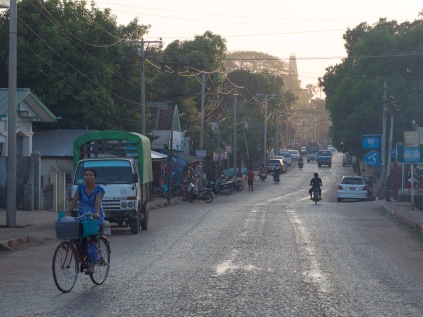




































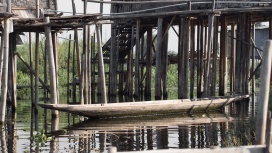
















 (Gid adds: Clare hadn’t seen this then, from the top of the descent)
(Gid adds: Clare hadn’t seen this then, from the top of the descent)

























































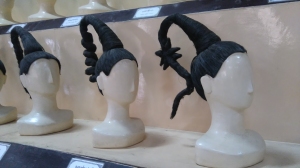 Around we trudged with a trail of others to all the top sights stealing a bit of respite from the heat in Bagan’s magnificent new Archaeological museum where we saw room after yet another large room displaying dozens of Buddha images, and some interesting cultural displays.
Around we trudged with a trail of others to all the top sights stealing a bit of respite from the heat in Bagan’s magnificent new Archaeological museum where we saw room after yet another large room displaying dozens of Buddha images, and some interesting cultural displays.






